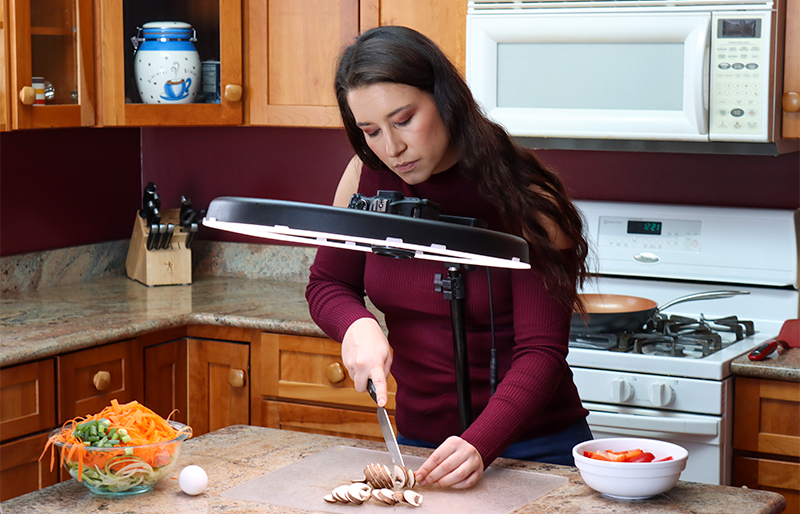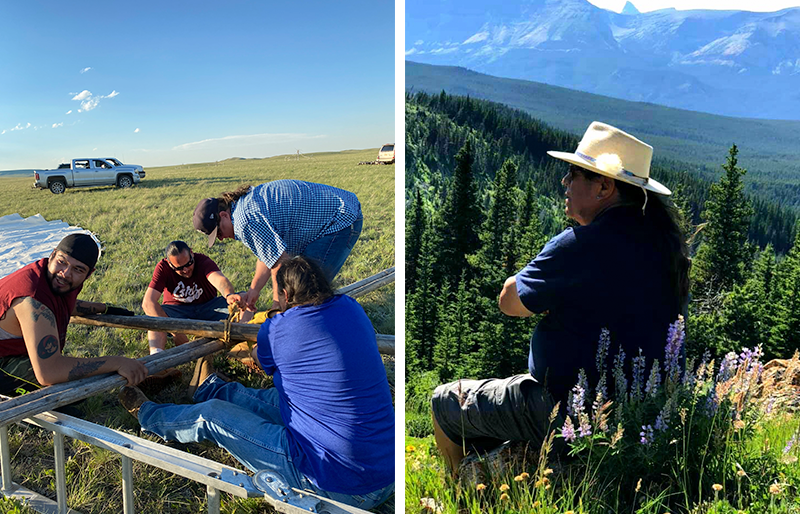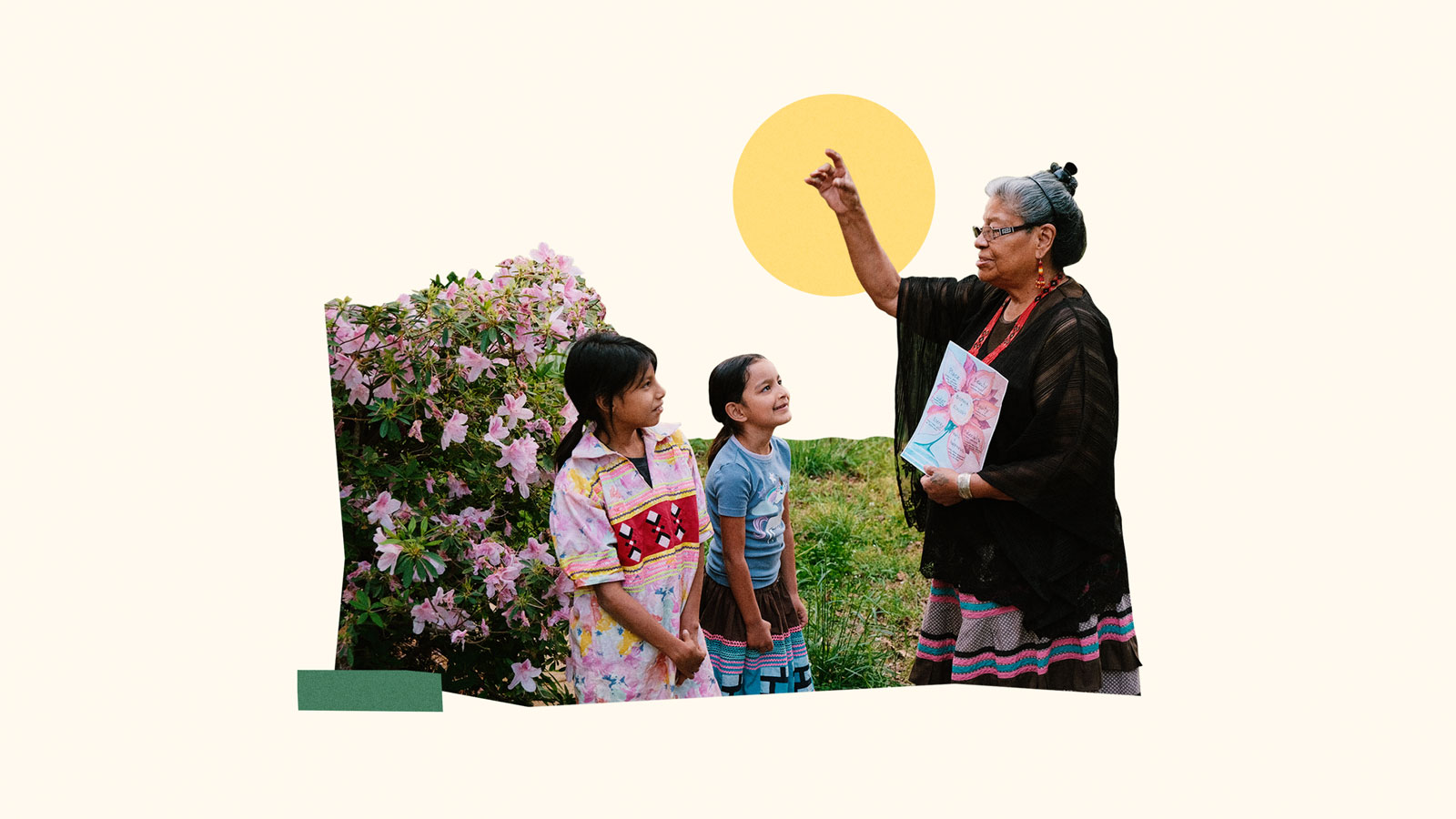This story is part of Fix’s Mentorship Issue exploring the unique ways climate leaders found their calling, and how new approaches to mentorship are upending old power structures. Check out the full issue here.
The first time Mariah Gladstone attended a bundle ceremony, she had a lot to learn about protocol. “I called my mom, so at least I knew to wear a skirt and bring a shawl,” she says. But she didn’t bring a pin to fasten the shawl, so she had to hold it with her hands to keep her shoulders covered. She didn’t know when she was supposed to get up and dance, and did her best to follow along.
“It’s like if you were to walk into a church, and everyone’s singing the songs, and they all seem to know what’s going on. And you have no idea what’s going on,” Gladstone says. But, after muddling through, she was able to use her experience to coach her cousins through some of their first ceremonies.
In Indigenous ceremonies like the bundle opening Gladstone attended earlier this year, it’s rare for anyone to explain the customs as they’re performed. Traditionally, those rites and other practices would be passed down organically, with elders modeling them for younger generations. But as Indigenous people were separated from their culture and ways of life by centuries of colonialism, genocide, and forced assimilation, that flow of knowledge ebbed. Today, many Native people are reclaiming and revitalizing ceremonies, foodways, and land stewardship — and in many cases, discovering that to preserve their traditions, they must embrace new ways of passing them along.
[Read: How the Indigenous landback movement is poised to change conservation]
“The elders and the leaders of those ceremonies are really making it a point to explain now what’s going on — why we’re doing the things that we’re doing — when previously those were things that you learned from going repeatedly, time after time,” Gladstone says.
That push to formalize a traditionally unstructured form of teaching and mentorship is being driven by several factors. There is a growing understanding that Native traditions, particularly with regard to land stewardship, may provide solutions to the climate crisis — and a growing thirst for this expertise within and beyond Indigenous communities. Just this month, the White House Office of Science and Technology Policy and the Council on Environmental Quality issued an unprecedented memorandum recognizing that Indigenous ecological knowledge should inform federal policymaking. The commitment is the first step in developing government-wide guidance on how to engage with tribes and elevate traditional knowledge. “Tribal and Native communities have stewarded these lands since time immemorial,” said CEQ Chair Brenda Mallory. “Their voices and their expertise are critical to finding solutions to address the climate crisis.”
Even more pressing is the dwindling number of elders with first-hand experience in these customs — a crisis exacerbated by the pandemic, which has devastated the Indigenous community. American Indians and Alaska Natives were 3.5 times more likely to contract COVID than white people and almost twice as likely to die from it, according to the CDC. The toll exposed an already failing health system and chronic disinvestment in Native communities; under normal circumstances, life expectancy for Indigenous people in the U.S. is 5.5 years below the average for all races. That has contributed to a renewed sense of urgency around transferring as much cultural knowledge as possible before it dies with the older generations.
“Because intergenerational transmission of language has been so fragmented in most Indigenous communities, we are literally living in a time where we are witnessing the very last generation of elders that can share traditional knowledge, with impeccable command, in their respective languages,” says Marcus Briggs-Cloud, a Maskoke scholar and the director of Ekvn-Yefolecv, an independent Maskoke ecovillage on traditional homelands in Alabama. “The elders tell us that it’s important we learn as much as we can now because there will come a time when children will be asking us questions, and it will be a shame if we cannot answer them.”
Gladstone, who is of Blackfeet and Cherokee descent, grew up about two hours from Blackfeet Nation in Montana. She didn’t attend ceremonies as a kid, but she was raised on her grandfather’s stories, and on local and traditional foods — wild game that family members hunted and produce from a garden that she was responsible for tending. But as she got older, and was exposed to the concept of food sovereignty, she recognized that many Indigenous folks lacked the kind of access that she had. It wasn’t until 2012 that the Blackfeet Nation, where Gladstone now lives, opened its first tribal-owned grocery store, bringing the grand total of supermarkets on the 1.5-million-acre reservation to two.
And accessibility is only half the equation — knowledge is the other half. “We can’t just introduce fresh foods into the community,” Gladstone says. “They need to know what to do with those foods. They need to know how to prepare them; at the end of the day, when they get home from work, their kids need to eat them and recognize them as food.”
In 2016, she started a project called Indigikitchen (a portmanteau of Indigenous, digital, and kitchen) to share recipes and cooking videos that honor Native ingredients and traditions. (Read more on the 2018 Grist 50 list, where Gladstone was featured as a Fixer.)

She figured she could share what she knew, but the project was also a learning journey for her. The very first recipe on Indigikitchen was a Potowatomi rice dish that a college friend of hers used to bring to potlucks. She sought out Native chefs, botanists, farmers, seed-savers, and elders within her community to deepen her own knowledge and share what she learned.
“There’s so many people who are interested in this information, and there’s so much knowledge that I have no idea about,” Gladstone says.
Her latest project is collecting recipes from elders and knowledge keepers all over the country and creating videos to share on the platform. She’d planned to travel the country, meeting folks in person and documenting them cooking in their kitchens. But when COVID scuttled those plans, the project went fully digital. She interviewed people on Zoom, and as they talked through the recipes and any stories and memories associated with them, Gladstone worked to recreate the dishes — showing only her hands in the video, to keep the spotlight on the storytellers.
“I have folks from coast to coast and down into South America,” says Gladstone. “They have resources that they want to be able to give to their community, but they may not have the video software to do it. They may not have the platform to be able to share and create.”
[Read: What is the Indigenous landback movement, and can it help the climate?]
Since moving to the reservation as an adult, Gladstone has also connected her knowledge of traditional food with participation in ceremonies and other lifeways — all practices that relate to and inform one another. The beaver bundle ceremony, for example, happens every spring and fall, and celebrates life, relation to animals, and the sacredness of water. According to Leon Rattler, an educator and beaver bundle carrier, teachings like this are part of revitalizing connection with the land and the seasons. “Climate change is very noticeable when you start to pay attention to the plants and the animals and the changes they’re going through,” Rattler says. “That affects our life, that affects our food.”
Such ceremonies are common within the Blackfeet Nation. But members of the tribe who live outside the reservation often don’t get the same exposure. The largest Blackfeet population outside of Montana lives in Seattle where, in recent years, the community has made an effort to revitalize traditional knowledge and practices.
In 2019, Rattler says, another beaver bundle carrier wanted to lead a ceremony in Seattle — something that was very rare at the time. From that initiative, a total of five bundles and bundle keepers wound up converging in the city. “We only used one to open for the ceremony,” Rattler says, “but it’s unheard of that that many bundles would be in one place at one time, outside the Blackfeet arena.”
That became a rallying point for Seattle’s Blackfeet community and helped catalyze an organization called Mopistun Four Directions. “Mopistun, that’s a beaver bundle. ‘Four Directions’ [refers to] the individuals who are based up in urban areas,” Rattler says. He’s one of the leaders of the organization; Gladstone is also on the board, along with some members of her family in the Pacific Northwest.
In addition to bringing ceremonial practices to Seattle, Mopistun Four Directions offers workshops on medicinal plants, hunting and butchering practices, powwow singing and drumming, and other topics. The vision is to bring together Blackfeet families throughout the Pacific Northwest to rediscover and practice traditional lifeways together. Rattler and Christine Mackay, another leader, are also writing a manual of Blackfeet cultural practices that will become a digital library to preserve and proliferate traditional knowledge.
“All the questions that people have asked me over the years, I wrote them all down. And then I started to answer those questions,” Rattler says. That’s hugely beneficial in terms of transferring information from a knowledge keeper like Rattler to a wide audience that wants to learn and may not have the opportunity to be mentored by him directly. But the balance of what should be documented and what should be kept private can be contentious among Indigenous communities, due to a long history of knowledge being distorted or exploited by outsiders.
“There will come a time when children will be asking us questions, and it will be a shame if we cannot answer them.”
—Marcus Briggs-Cloud
“Within Blackfoot and Blackfeet communities, we’ve often welcomed in folks who are interested in learning about our communities,” Gladstone says. “So there’s been a fair amount of anthropological research and work done by non-Native people.” Including, notably, Abraham Maslow, whose famous hierarchy of needs was likely based on time he spent with the Blackfoot confederacy in southern Alberta, Canada. “But that’s not how we explain our hierarchy of needs,” Gladstone says of Maslow’s work. For instance, the focus on self-actualization didn’t account for a holistic view of community well-being or attachment to place. Maslow brought the philosophy to the mainstream, but he got it twisted.
It has been widely recognized that Indigenous knowledge of things like land management can and should provide a basis for how we respond to the climate crisis. A 2018 special report from the U.N. Intergovernmental Panel on Climate Change states that there is “medium evidence and high agreement” that Indigenous knowledge will be crucial for climate adaptation. The report also states that climate policies “if based on limited understanding of Indigenous worldviews” can exacerbate the disproportionate vulnerability to climate change that Native communities experience. Because of that risk, tribes are understandably wary about sharing knowledge that could be used incorrectly, or without giving Indigenous leaders a seat at the table, as has often happened in history.
“It’s interesting to navigate, because we also want to document these things,” Gladstone says. “We want future generations to be able to know these things as they come from this time, and to be able to hear it in our voices.”
Ensuring that the proverbial mic stays with Indigenous voices, and not with interpreters like Maslow, may be the key to sharing knowledge in a way that benefits all. On Indigikitchen, for example, Gladstone ensures that the people who share recipes and stories retain the rights to them. If anyone were to object to how their information was presented, or simply decide they didn’t want it shared, they could pull it from the platform. In the case of the cultural practices manual from Mopistun Four Directions, it’s just an entry point. “If [people] want to learn more, then they need to attend the ceremonies, they need to take part,” Rattler says.
These projects make traditional knowledge accessible to a modern audience that does much of its learning and information-seeking online. But there will always be some things that are not shared in a public forum — and some meaning that can’t fully be conveyed when teachings are translated to English.

That’s one reason why language preservation is of the utmost importance, to leaders like Briggs-Cloud and others. As Briggs-Cloud studied the Maskoke language, the grammar patterns revealed how his ancestors saw and interacted with the world around them. Saving the language requires saving that traditional way of life, and vice versa. That was the idea behind the community at Ekvn-Yefolecv, which has a double meaning — “returning to the earth” and “returning to our homelands,” in Maskoke.
From the outset, elders were central to building the vision for the ecovillage, which includes a language immersion school, regenerative farming practices, traditional diets, ceremonies, and natural building practices — all of which support the health of elders and the transfer of knowledge to all community members. “They say that if you actively share your elder teachings with the younger generation of your clan, never being stingy with those teachings, you will live a long life,” says Briggs-Cloud, a 2020 Grist 50 honoree.
Similarly, when people ask Gladstone what they can do to help rebuild Indigenous food systems, she tells them to share the information that they have. “Some people may know that this berry’s edible, and you harvest it in August, or whatever it is,” she says. Everyone has pieces of the puzzle that have been passed down from relatives or other mentors. If they teach others, the knowledge grows and can help build healthier and more resilient communities.
“This is a time-sensitive thing,” Gladstone says. “The more that we can document and share that information now in ways where people will actually use it and connect with it, the more changes and resurgence of knowledge we can really cultivate.”
Explore more from Fix’s Mentorship Issue:
- What happens when communities and academics teach each other? ‘Communiversity.’
- How Avatar: The Last Airbender created a generation of climate activists
- On mentorship: Climate leaders in conversation



